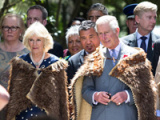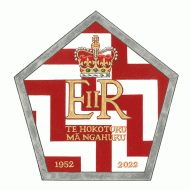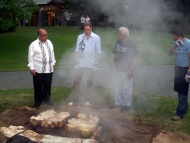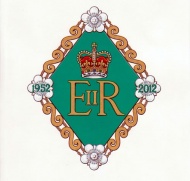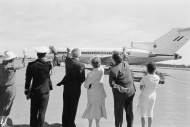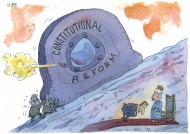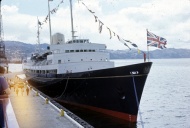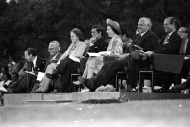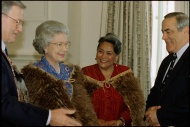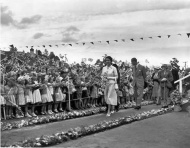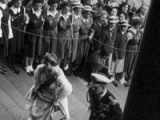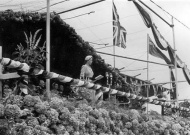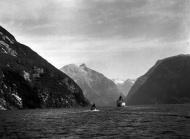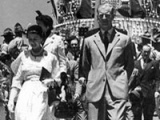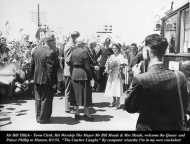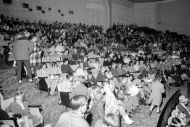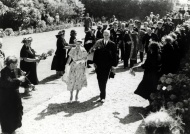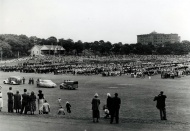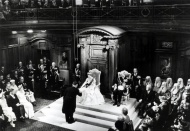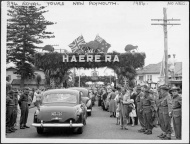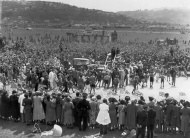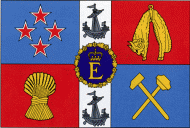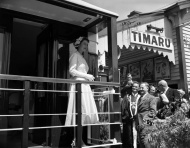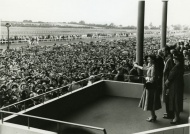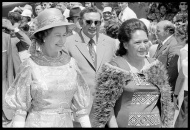Events In History
-
 22 May 1995Waikato-Tainui sign Deed of Settlement with the Crown
22 May 1995Waikato-Tainui sign Deed of Settlement with the CrownWaikato–Tainui was the first iwi to reach a Treaty of Waitangi settlement with the Crown for injustices that went back to the 1860s. The Deed of Settlement included cash and land valued at a total of $170 million. Read more...
-
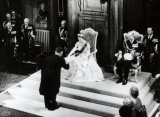 12 January 1954Queen Elizabeth II opens Parliament
12 January 1954Queen Elizabeth II opens ParliamentA crowd of 50,000 greeted Queen Elizabeth II, resplendent in her coronation gown, when she opened a special session of the New Zealand Parliament in its centennial year. Read more...
-
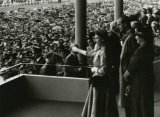 23 December 1953Queen Elizabeth II arrives for royal tour
23 December 1953Queen Elizabeth II arrives for royal tourFor the New Zealanders who experienced it, the visit of the young Queen and her dashing husband, Prince Philip, in the summer of 1953–4 was a never-to-be forgotten event. Read more...
Articles
Royal Visit of 1953-54
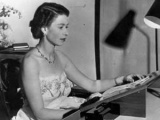
For those New Zealanders who experienced it, the visit of the young Queen and her dashing husband, Prince Philip, to New Zealand in the summer of 1953-54 was a never-to-be forgotten event.
-
Page 2 – Itinerary
The progress of the royal visit down the length of the country
-
Page 3 – Popularity
Why was the royal visit of 1953/4 greeted with such enthusiasm by New Zealanders?
-
Page 4 – The Queen and Māori
For many Māori the royal visit raised important issues about their place in New Zealand.
-
Page 5 – A pastoral paradise
Following their stay in Auckland and visits to Waitangi, Hamilton and Rotorua, the Queen and Duke had a two-day break at Lake Rotoiti before flying to Gisborne and Napier.
-
Page 6 – A loyal people
As head of the Church of England the Queen laid the foundation stone of the new Anglican cathedral in Wellington, and as head of the Commonwealth's armed forces she laid
-
Page 7 – Great place to bring up children
On the day of the reception for children at Athletic Park, the Evening Post wrote: 'As the mother of two young children 12,000 miles away, the Queen today assumed the
-
Page 8 – Remembering the royals
Memories from around the country of the 1953-54 royal tour to New Zealand
-
Page 9 – Later royal visits
On 30 January 1954 the Gothic sailed from Bluff and after a brief side trip into Milford Sound, Queen Elizabeth and Prince Philip departed for Australia. They have returned
-
Page 10 – Further information
Recommended books and websites relating to the 1953-4 Royal Tour
History of the Governor-General
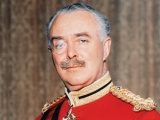
New Zealand has had a governor or (from 1917) a governor-general since 1840. The work of these men and women has reflected the constitutional and political history of New Zealand in many ways.
-
Page 8 – Uber diplomat?
From 1926, in accordance with decisions taken as a consequence of the Balfour Declaration, governors-general merely represented the sovereign in New Zealand.
Queen Elizabeth II

Queen Elizabeth II became New Zealand's monarch on 6 February 1952, following the death of her father, King George VI
-
Page 2 – Constitutional and public ceremonial roles
The Queen was New Zealand’s head of state. Her title was confirmed by Royal Titles Acts of 1953 and 1974, the latter entitling her ‘Elizabeth the Second, by the Grace of God
-
Page 3 – Royal tours
About three out of every four New Zealanders saw the Queen as she visited 46 centres and attended 110 functions in 1953-54
-
Page 4 – Māori and the Queen
Māori ‘were primarily concerned to express their loyalty to the Crown and to win acceptance as New Zealand citizens.’ They were just as enthusiastic about the tour as other New
-
Page 5 – Changing attitudes to monarchy
The post-war social consensus began to fray in the 1960s. More frequent visits by the Queen and other members of her family reduced some of the mystique. At the same time,
-
Page 6 – Further information
Links and books relating to the reign of Queen Elizabeth II and New Zealand
King Charles III
Waitangi Day
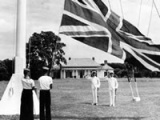
Every year on 6 February, New Zealand marks the signing of the Treaty of Waitangi in 1840. For most people, Waitangi Day is a holiday; for many, and especially for Māori, it is a time for reflecting on the Treaty and its place in modern New Zealand.
- Page 4 - Waitangi Day 1960sThe Waitangi Day Act 1960 declared 6 February to be Waitangi Day; a national day of thanksgiving in commemoration of the signing of the Treaty of
State housing

New Zealand's first state house was formally opened on 18 September 1937. But the government has provided rental housing for New Zealanders for more than a century. Explore the history of this country's various state housing schemes and their contribution to the New Zealand way of life.
- Page 7 - State house styleThe design of state houses has been fodder for armchair and professional critics since the beginning. Detractors slagged the first workers' dwellings for being 'too swell' and
Flags of New Zealand
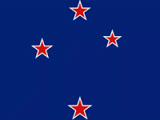
The New Zealand flag hasn't always been our official flag. It was adopted in 1902, replacing the Union Jack. Between 1834 and 1840, the flag of the United Tribes was recognised as our first 'national' flag. Waitangi Day 2010 saw the first official recognition of the national Māori flag.
- Page 5 - Other official flagsSix flags other than the New Zealand flag are flown for official purposes in New
Parliament Buildings
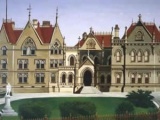
Parliament buildings have been modified, destroyed by fire, half-built and restored; the parliamentary places and spaces have formed an important part of New Zealand's history.
- Page 5 - Doing up the HouseIn 1992 the biggest heritage building conservation project in New Zealand was undertaken with the strengthening and refurbishing of Parliament House and the Parliamentary
Related keywords
- royal tours
- king charles
- prince of wales
- governor-general
- prince william
- national identity
- royalty
- air force
- royal new zealand air force
- david lange
- paul reeves
- air transport
- arthur porritt
- britannia
- cartoon
- wellington city
- shipping
- transport
- waitangi day
- waitangi
- 1970s
- norman kirk
- children
- auckland domain
- families
- parliament buildings
- architecture
- RSA
- agriculture
- government
- catherine tizard
- treaty of waitangi
- te atairangikaahu
- jim bolger
- tainui
- stratford
- railway stations
- christchurch
- palmerston
- communism
- parliament
- greymouth
- milford sound
- nelson city
- radio broadcasts
- queen street
- auckland city
- race relations
- maori
- marton
- masterton
- tangiwai disaster
- turangawaewae
- movies
- 1960s
- hastings
- watties
- new plymouth
- dairying
- bell block
- maori leaders
- king koroki
- kingitanga
- sidney holland
- flags
- dunedin
- 1950s
- janet frame
- edmund hillary
- sonja davies
- state housing
- porirua
- christmas
- waikato
- timaru
- horse racing
- ngaruawahia
- public holidays
- housing
- maori housing
- royal new zealand navy
- governor
-
Main image: A private audience with Her Majesty
The Queen and Governor-General meeting by video call

